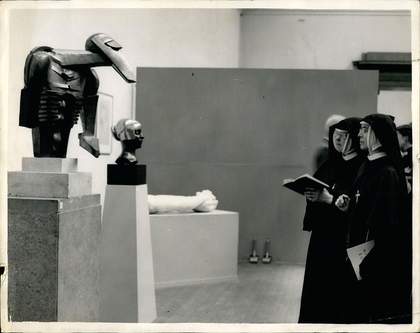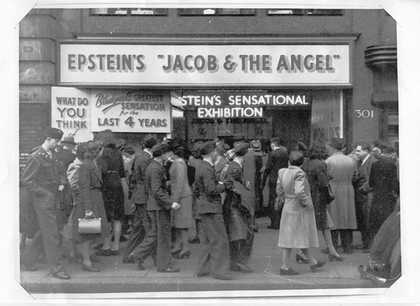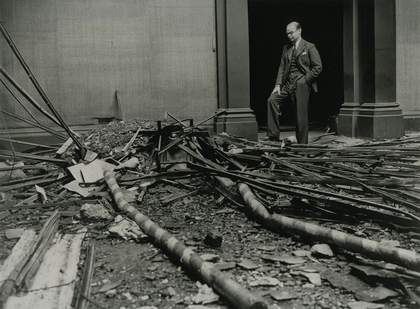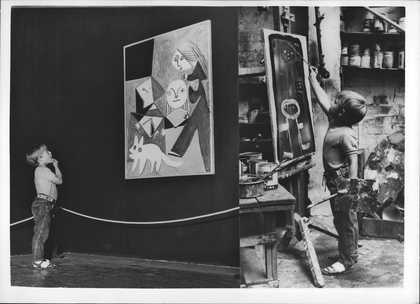
Jacob Epstein’s Torso in Metal from ‘The Rock Drill’ 1913–15 photographed during a private view of his retrospective exhibition at Tate Gallery, London, September 1952
Keystone Press / Alamy Stock Photo
‘Here is the armed, sinister figure of today and tomorrow. No humanity, only the terrible Frankenstein’s monster we have made ourselves into...’ So wrote Jacob Epstein in 1940 of his sculpture Rock Drill, a later version of which (named Torso in Metal from ‘The Rock Drill’ 1913–15) is seen here being viewed intently at Tate’s exhibition of the artist in 1952.
First conceived a year before the outbreak of the First World War, Epstein would, in later interviews and articles, regard its creation as his prescient symbol of the mechanisation of the war and the depersonalisation of human behaviour, describing it as ‘a machine-like robot, visored, menacing and carrying within itself its progeny, protectively ensconced’. And it would go on to epitomise the chilly technological future that continues today in the form of artificial intelligence.
In his original, a complete plaster figure stood atop a real industrial rock drill, like the ones he remembered seeing as a child on the streets of New York, and was perhaps also inspired by his time working as a young man in a bronze foundry in the American city. After it was shown in 1915, he dismantled the sculpture by removing the drill, truncating the arms of the torso and casting the remaining figure in bronze (which is now in Tate’s collection). Epstein’s work subsequently moved away from the vorticist language of the machine and would focus on figurative sculptures, such as Tate’s Jacob and the Angel 1940–1 and numerous portrait heads.
Despite this, the legacy of Rock Drill lives on. As well as influencing artists such as Mark Leckey, the work has also inspired several generations of musicians. The Sensational Alex Harvey Band called their last album Rock Drill (1977) with a moody cover photograph of the Torso in Metal from ‘The Rock Drill’, and in 2006 The Chemical Brothers recorded ‘The Rock Drill’, a track inspired by the sculpture.
And could filmmaker George Lucas also be a fan? General Grievous, the cyborg leader of the of the Separatist Droid Army in Star Wars: Episode III – Revenge of the Sith (2005) and his battle droids bear a striking resemblance to Epstein’s creation.
Torso in Metal from ‘The Rock Drill’ is included in the display Vorticism at Tate Britain.



